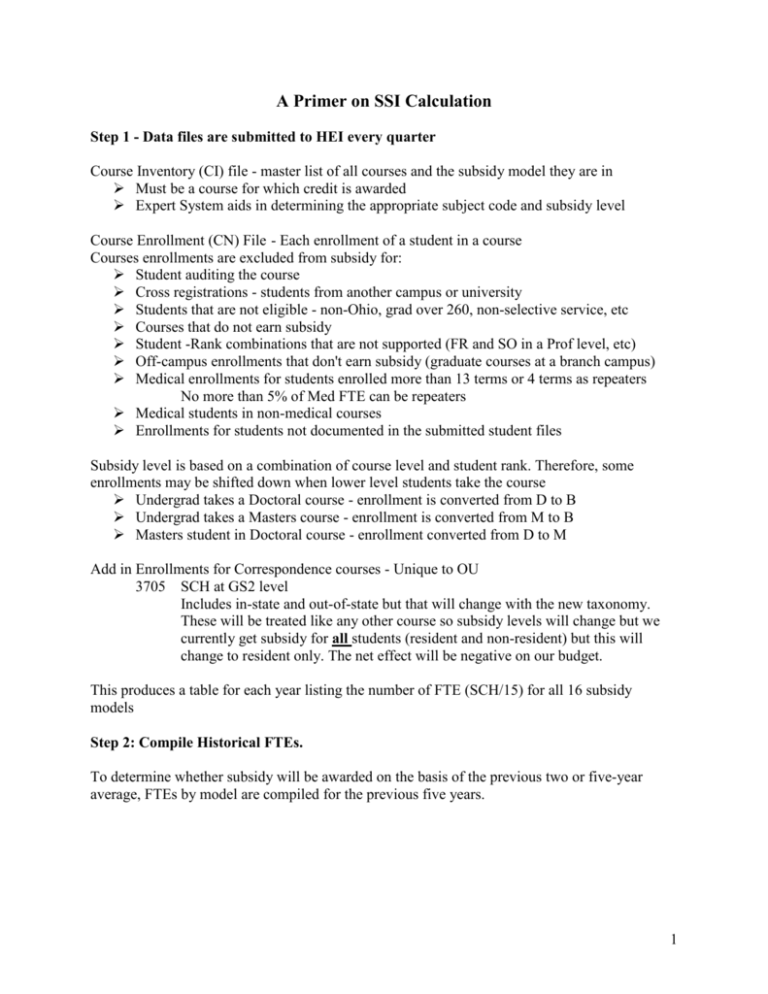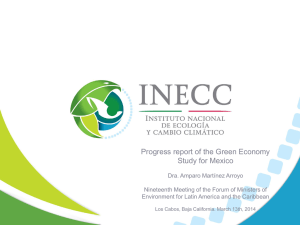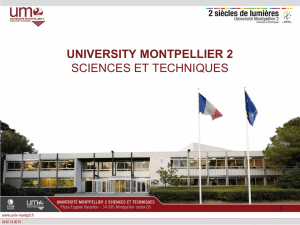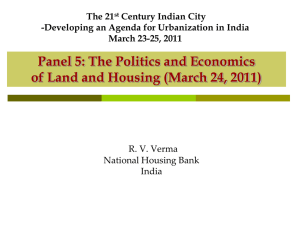How Subsidy is Calculated
advertisement

A Primer on SSI Calculation Step 1 - Data files are submitted to HEI every quarter Course Inventory (CI) file - master list of all courses and the subsidy model they are in Must be a course for which credit is awarded Expert System aids in determining the appropriate subject code and subsidy level Course Enrollment (CN) File - Each enrollment of a student in a course Courses enrollments are excluded from subsidy for: Student auditing the course Cross registrations - students from another campus or university Students that are not eligible - non-Ohio, grad over 260, non-selective service, etc Courses that do not earn subsidy Student -Rank combinations that are not supported (FR and SO in a Prof level, etc) Off-campus enrollments that don't earn subsidy (graduate courses at a branch campus) Medical enrollments for students enrolled more than 13 terms or 4 terms as repeaters No more than 5% of Med FTE can be repeaters Medical students in non-medical courses Enrollments for students not documented in the submitted student files Subsidy level is based on a combination of course level and student rank. Therefore, some enrollments may be shifted down when lower level students take the course Undergrad takes a Doctoral course - enrollment is converted from D to B Undergrad takes a Masters course - enrollment is converted from M to B Masters student in Doctoral course - enrollment converted from D to M Add in Enrollments for Correspondence courses - Unique to OU 3705 SCH at GS2 level Includes in-state and out-of-state but that will change with the new taxonomy. These will be treated like any other course so subsidy levels will change but we currently get subsidy for all students (resident and non-resident) but this will change to resident only. The net effect will be negative on our budget. This produces a table for each year listing the number of FTE (SCH/15) for all 16 subsidy models Step 2: Compile Historical FTEs. To determine whether subsidy will be awarded on the basis of the previous two or five-year average, FTEs by model are compiled for the previous five years. 1 GENERAL STUDIES I GENERAL STUDIES II GENERAL STUDIES III TECHNICAL I TECHNICAL III BACCALAUREATE I BACCALAUREATE II BACCALAUREATE III MASTERS & PROF I MASTERS & PROF II MASTERS & PROF III DOCTORAL I DOCTORAL II MEDICAL I MEDICAL II Blended MPD1 TOTAL FY 2001 2,320 2,709 1,032 43 0 4,181 3,698 1,715 0 1,114 267 376 267 0 441 476 18,639 FY2002 2,439 2,770 986 44 0 4,462 3,837 1,761 0 1,150 269 340 275 0 452 445 19,230 FY2003 2365 2930 1046 50 0 4566 3906 1713 0 1196 266 345 296 0 437 518 19634 FY2004 2,468 2,968 789 51 0 4,806 3,856 1,707 0 1,198 249 346 354 0 439 484 19,715 FY2005 2,470 2,969 801 57 0 4,854 3,754 1,681 0 1,124 226 356 331 0 434 476 19,533 Step 3: Calculate 2 and 5-year FTE Averages These FTEs are then used to calculate two and five-year averages as follows: GENERAL STUDIES I GENERAL STUDIES II GENERAL STUDIES III TECHNICAL I TECHNICAL III BACCALAUREATE I BACCALAUREATE II BACCALAUREATE III MASTERS & PROF I MASTERS & PROF II MASTERS & PROF III DOCTORAL I DOCTORAL II MEDICAL I MEDICAL II Blended MPD1 TOTAL 2-year Average 2,469 2,969 795 54 0 4,830 3,805 1,694 0 1,161 238 351 343 0 437 480 19,624 5-year Average 2,412 2,869 931 49 0 4,574 3,810 1,715 0 1,156 255 353 305 0 441 480 19,350 2 Step 4: Determine Dollars Earned for Instruction & Support Base Rates are determined by the State using certain inflationary assumptions as well as what the State will provide in terms of percentage of support. These rates determine the dollars earned for instruction, student services and space costs. Base Rates GENERAL STUDIES I GENERAL STUDIES II GENERAL STUDIES III TECHNICAL I TECHNICAL III BACCALAUREATE I BACCALAUREATE II BACCALAUREATE III MASTERS & PROF I MASTERS & PROF II MASTERS & PROF III DOCTORAL I DOCTORAL II MEDICAL I MEDICAL II Blended MPD1 Instruction & Support 4,655 5,135 6,365 5,926 9,107 7,160 8,235 11,841 19,088 20,984 27,234 23,093 22,606 29,143 37,172 13,645 Local Contribution 4,983 4,983 4,983 4,983 4,983 6,169 6,169 6,169 11,922 11,922 11,922 11,922 11,922 14,437 18,982 11,922 State Support Per FTE (328) 152 1,382 943 4,124 991 2,066 5,672 7,166 9,062 15,312 11,171 10,684 14,706 18,190 1,723 Student Services 890 890 890 890 890 890 890 890 890 890 890 890 890 890 890 890 POM 512 662 1,464 752 1,343 639 1,149 1,262 1,258 2,446 3,276 1,759 2,093 1,967 3,908 1,081 The Instruction & Support cost minus the Local Contribution (paid through tuition) gives the State Support per FTE. This dollar value is then multiplied by our 2-Year and 5-Year FTE to determine the subsidy provided for our SCH activity (Total excludes Doctoral) GENERAL STUDIES I GENERAL STUDIES II GENERAL STUDIES III TECHNICAL I TECHNICAL III BACCALAUREATE I BACCALAUREATE II BACCALAUREATE III MASTERS & PROF I MASTERS & PROF II MASTERS & PROF III DOCTORAL I DOCTORAL II MEDICAL I MEDICAL II Blended MPD1 TOTAL 2-Year Average ($809,832) $451,212 $1,098,690 $50,922 $0 $4,786,530 $7,861,130 $9,606,950 $0 $10,520,982 $3,636,600 $3,921,021 $3,659,270 $0 $7,939,935 827,040 $45,970,159 5-year Average ($791,267) $436,118 $1,286,366 $46,207 $0 $4,532,636 $7,871,873 $9,728,501 $0 $10,479,297 $3,910,685 $3,938,895 $3,254,346 $0 $8,014,514 826,695 $46,341,625 3 Step 5: Determine Subsidy Earned for Student Services The FTE for each model (2-year and 5-year) are multiplied by the Student Services subsidy amount (now simply $890 per FTE regardless of model) and then multiplied by the OU Student Services weight (Modified Headcount to FTE ratio) – 1.014 for OU. The results are as follows: GENERAL STUDIES I GENERAL STUDIES II GENERAL STUDIES III TECHNICAL I TECHNICAL III BACCALAUREATE I BACCALAUREATE II BACCALAUREATE III MASTERS & PROF I MASTERS & PROF II MASTERS & PROF III DOCTORAL I DOCTORAL II MEDICAL I MEDICAL II Blended MPD1 TOTAL 2-Year Average $2,228,783 $2,679,685 $717,652 $48,746 $0 $4,360,074 $3,434,799 $1,528,960 $0 $1,048,043 $214,393 $316,850 $309,177 $0 $394,032 433,299 $17,088,466 5-year Average $2,177,690 $2,590,046 $840,239 $44,233 $0 $4,128,800 $3,439,493 $1,548,305 $0 $1,043,890 $230,551 $318,294 $274,964 $0 $397,733 433,119 $16,874,099 Step 6: Determine the Subsidy Earned for Activity-Based POM The FTE for each model (2-year and 5-year) are multiplied by the POM subsidy amount (see Base Rate table in Step 4) and then multiplied by the OU Activity POM weight – 1.114 for OU. The results are as follows: GENERAL STUDIES I GENERAL STUDIES II GENERAL STUDIES III TECHNICAL I TECHNICAL III BACCALAUREATE I BACCALAUREATE II BACCALAUREATE III MASTERS & PROF I MASTERS & PROF II MASTERS & PROF III DOCTORAL I DOCTORAL II MEDICAL I MEDICAL II Blended MPD1 TOTAL 2-Year Average $1,408,239 $2,189,174 $1,296,562 $45,237 $0 $3,438,216 $4,870,347 $2,381,189 $0 $3,163,544 $866,748 $687,794 $798,574 $0 $1,900,308 578,032 $22,137,596 5-year Average $1,375,956 $2,115,943 $1,518,038 $41,049 $0 $3,255,841 $4,877,003 $2,411,317 $0 $3,151,010 $932,073 $690,929 $710,206 $0 $1,918,157 577,791 $22,174,178 4 Step 7: Determining Which Average to Use Once the subsidy amounts are computed for Instruction & Support, Student Services and POM, these three amounts are added to come up with total subsidy for both the 2-year and 5-year FTE averages: GENERAL STUDIES I GENERAL STUDIES II GENERAL STUDIES III TECHNICAL I TECHNICAL III BACCALAUREATE I BACCALAUREATE II BACCALAUREATE III MASTERS & PROF I MASTERS & PROF II MASTERS & PROF III DOCTORAL I DOCTORAL II MEDICAL I MEDICAL II Blended MPD1 TOTAL 2-Year Average $2,827,190 $5,320,071 $3,112,904 $144,905 $0 $12,584,820 $16,166,276 $13,517,099 $0 $14,732,569 $4,717,741 $4,925,665 $4,767,021 $0 $10,234,275 1,838,371 $85,196,221 5-year Average $2,762,379 $5,142,107 $3,644,643 $131,489 $0 $11,917,277 $16,188,369 $13,688,123 $0 $14,674,197 $5,073,309 $4,948,118 $4,239,516 $0 $10,330,404 1,837,605 $85,389,902 Note that these totals do not include the doctoral amounts. Those are only shown for reference. The greater of these two totals is then used. In this case the 5-year average is used since it results in more total subsidy. Step 8: Calculate Doctoral Subsidy For each university in the system, the Doctoral I equivalents (D1 + D2*1.5) were computed for each year from 1994 through 1998. FTEs from these five years were then adjusted as follows: FTEs from programs that were determined to be ineligible for state share of instruction funding were subtracted and FTEs in new programs were added as they matured and stabilized enrollments. A later adjustment allowed FTEs for non-doctorate rank students taking doctoral courses in Business and Education to be funded in the Blended MPD1 Model. Therefore, the base doctoral FTE were reduced for this change. These adjusted FTEs were then averaged to get a two-year (FY97+FY98) and five-year (FY94FY98 average. The larger of the two then becomes the base for that university. The base for each university is then listed and a total is computed (12,028 FTE) for the overall base for the system. Subsidy earned is then computed as shown in the following table: 5 University AKRON BOWLING GREEN CENTRAL STATE CINCINNATI CLEVELAND KENT MIAMI OHIO STATE OHIO UNIV SHAWNEE TOLEDO WRIGHT YOUNGSTOWN MCOT NEOUCOM Total Base Doct. I Equivalent FTEs 760.710 685.480 0.000 2,260.650 172.070 1,002.520 436.800 5,076.120 850.180 0.000 295.660 339.840 31.420 116.500 0.000 12,027.95 Share of Doct. I Equivalents 6.32452% 5.69906% 0.00000% 18.79497% 1.43058% 8.33492% 3.63154% 42.20270% 7.06837% 0.00000% 2.45811% 2.82542% 0.26122% 0.96858% 0.00000% 100.00000% Unadjusted Share of Doctoral Set Aside, FY 2006 $158,744,009 $10,039,795 $9,046,915 $0 $29,835,894 $2,270,967 $13,231,186 $5,764,855 $66,994,262 $11,220,614 $0 $3,902,099 $4,485,184 $414,679 $1,537,559 $0 $158,744,009 FY 2006 Reduce for Loss of FTEs Below 15% Threshold (%) 12.197% 0.000% 0.000% 0.000% 0.000% 0.000% 0.000% 0.000% 0.000% 0.000% 0.000% 0.000% 14.333% 0.000% 0.000% Adjusted Share of Doctoral Set Aside, FY 2006 Reduced for 85% rule $8,815,258 $9,046,915 $0 $29,835,894 $2,270,967 $13,231,186 $5,764,855 $66,994,262 $11,220,614 $0 $3,902,099 $4,485,184 $355,243 $1,537,559 $0 $157,460,037 The Board of Regents determines each university’s percentage share of the overall FTE base of 12,028 (Share of Doctoral I Equivalents). In this case OU has around 7% of the total state doctoral FTE. The total dollars that will be spent on doctoral subsidy is calculated as 10.18% of the total subsidy appropriation in the system ($1,559.096.031) or $158,744,099. Each university then simply gets a share of these dollars in proportion to their share of the total FTE. The final doctoral adjustment involves reduction in subsidy for universities that drop below 85% of their expected base FTE as follows: 85% Rule Calculation for FY 2006 Doctoral Subsidy Benchmark Elig Doc for 85% Rule Equiv (FY 1999 FTEs) FY 2001 AKRON 696.70 597 BOWLING GREEN 599.48 412 CINCINNATI 1,843.22 1,662 CLEVELAND 162.93 152 KENT 976.83 891 MIAMI 444.68 330 OHIO STATE 4,611.89 4,354 OHIO UNIV 790.83 797 TOLEDO 321.69 370.60 WRIGHT 288.53 189 YOUNGSTOWN 20.00 11 MCOT 121.50 85 NEOUCOM 0.00 0 TOTAL 11,087.18 9,851 Elig Doc Equiv FY 2002 547.55 459.60 1,834.07 161.82 952.85 253.88 4,637.38 767.48 424.93 236.56 17.60 93.05 0.00 10,387 Elig Doc Equiv FY 2003 531.00 493.00 1,880.00 168.00 919.50 456.00 5,058.00 803.00 380.50 256.00 17.00 99.00 0.00 11,061 Elig Doc Equiv FY 2004 410.25 512.00 2,024.00 160.00 971.50 552.50 5,313.50 886.00 317.00 292.50 16.00 106.50 0.00 11,562 Elig Doc Equiv FY 2005 0.00 0.00 0.00 0.00 0.00 0.00 0.00 0.00 0.00 0.00 0.00 0.00 0.00 11,957 % change FY98 to FY05 -35.41% -10.59% 7.80% 0.04% 8.00% 25.59% 20.15% 8.94% 20.46% -2.78% -55.00% 4.94% 7.84% Greater of 2 or 5 year average 507 524 2,006 162 1,013 556 5,427 874 376 287 14 117 11,862 % ? FY98 vs 2-5 year average -27.20% -12.59% 8.80% -0.88% 3.73% 24.92% 17.68% 10.48% 16.92% -0.70% -29.33% -3.70% 6.99% FTE drop 85 0 0 0 0 0 0 0 0 0 3 0 0 88 The Doctoral Equivalent (D1+D2*1.5) FTE for FY2001 through 2005 is used to get a 2 or 5-year average (which ever is greater). 6 This average is compared to the FTE produced in 1999. If this average represents a drop (negative number) of more than 15% from 1999, then percentage over 15% is used as a reduction to their subsidy. Adjustments to Subsidy Once the basic amount of subsidy earned by the formula is calculated, there are potential adjustments related to POM, Stop-Loss (“The Guarantee”), Negative Capital Allocation, Late Space Adjustment, and System-Wide Reductions. POM Adjustment This is basically a guarantee for square-footage POM earnings (NASF POM). Earnings related to actual square footage are compared to the POM earnings calculated above based on FTEs (Activity POM). If the earnings based on square footage are greater than the activity-based, the difference is added to the subsidy total. Basically, those with more space than their activity would warrant are given extra subsidy to cover it. The calculation is as follows: We collect and submit our space data. A dollar rate per square foot is determined State-wide. This is applied to our square footage to get a subsidy amount for our space: AV-DP Circulation Classroom Labs Offices Storage-Mech Other Roads & Grounds Total FY 2005 Total 87,172 582,282 226,044 517,021 525,407 724,752 381,272 3,043,950 Rate Per NASF $7.31 $7.39 $5.86 $7.31 $5.86 $2.59 $5.86 Subsidy $655,070 $4,423,550 $1,361,707 $3,885,247 $3,165,094 $1,929,667 $2,296,813 $1,053,828 $18,770,975 Roads & Grounds has a separate calculation based on 1998 figures with certain inflationary assumptions as well as proportional reductions in various years. This represents our total space costs. To determine how much we get, we much reduce this in proportion to the percentage of our FTE that are not eligible for subsidy (basically we get support for space costs related to Ohio residents only). This calculation looks like this: 7 GENERAL STUDIES I GENERAL STUDIES II GENERAL STUDIES III TECHNICAL I TECHNICAL III BACCALAUREATE I BACCALAUREATE II BACCALAUREATE III MASTERS & PROF I MASTERS & PROF II MASTERS & PROF III DOCTORAL I DOCTORAL II MEDICAL I MEDICAL II Blended MPD1 TOTAL POM Allocation FY 2006 5.836% 8.975% 6.439% 0.174% 0.000% 13.810% 20.687% 10.228% 0.000% 13.366% 3.954% 2.931% 3.012% 0.000% 8.136% 2.451% 100.000% Allocation of Total POM Amounts $1,095,554 $1,684,742 $1,208,682 $32,684 $0 $2,592,344 $3,883,134 $1,919,922 $0 $2,508,876 $742,129 $550,127 $565,475 $0 $1,527,262 $460,045 $18,770,976 % Subsidy-Elig. FY 2005 FTES 91.75% 90.44% 92.82% 93.44% 0.00% 92.39% 90.46% 91.16% 0.00% 99.82% 100.00% 98.07% 98.22% 0.00% 100.00% 100.00% 0.00% Subsidy-Eligible % = POM Subsidy $1,005,207 $1,523,606 $1,121,847 $30,541 $0 $2,394,982 $3,512,599 $1,750,211 $0 $2,504,420 $742,129 $539,518 $555,407 $0 $1,527,262 $460,045 $16,572,849 We go back to the subsidy earned for Activity POM calculated in Step 6 (either the 2-year or 5year figures depending on which average we are using) and determine the percentage of the total Activity POM subsidy is earned under each model (POM Allocation FY 2006). Then the NASF POM subsidy total is distributed across the subsidy models in the same proportion (Allocation of Total POM Amounts). Then we determine the percentage of the subsidy eligible FTEs compared to total FTE for each model using the data in the most recently completed year (FY2005 in this case). For example, in FY2005, 91.75% of the G1 FTEs were subsidy eligible. The NASF POM subsidy is then computed for each model in proportion to the percentage of eligible FTE (Subsidy-Eligible % = POM Subsidy). In other words, we have the total space costs and then reduce that to the proportion of those costs that would be spent on eligible students. In this case, our Activity POM was $22,174,178 and our NASF POM was $16,572,849. So, our NASF POM is not greater than our Activity POM so no additional subsidy is going to come from us having more space than our activity would warrant. This adjustment is being phased out. Stop Loss (“The Guarantee”) Each campus is usually guaranteed some percentage of the previous year’s subsidy allocation to buffer the impact of variations in funds as FTE production shifts within the system, as well as formula changes. A variety of methods and philosophies have been used to determine the amount of protection that is provided. These include: a) 100% of the previous year, b) 100% of the previous year after a percentage cut, c) 99% of 99% or 98.01%, and d) 97%. Over the last 5 years, OU has received various amounts under the Stop Loss as follows: 8 Minimum Funding Level University Earnings Level Amount of Protection FY2002 FY2003 FY2004 FY2005 $111,710,427 $106,764,372 $105,150,254 $103,035,359 $113,922,004 $115,897,768 $93,417,110 $99,899,192 $0 $0 $11,733,144 $3,136,167 FY2006 $99,283,330 $96,610,516 $2,672,814 For FY2006 each campus is guaranteed 97% of it previous year (FY 2005) subsidy. Negative Capital Adjustment If the debt service charges for a campus exceed the formula capital allocation, the subsidy for that university is reduced and transferred to their capital component. This calculation is made after the stop-loss calculation. This only affects a few schools like Hocking, James Rhodes State, Trumbull, Walters and the new NE Ohio COM. Late Space Adjustment This involves space changes that were projected to occur in December of the prior year. If the projected space change affected a campus's subsidy, and if the change did not actually occur, the adjustment is made in the following year to correct for the overpayment. This rarely occurs. System-Wide Reductions If the total earnings by the formula exceed the amount appropriated, the earnings for each institution will be reduced proportionally. For the last five years those adjustments have looked like this: System Total Appropriated Reduction Percent FY2002 FY2003 FY2004 FY2005 FY2006 $1,664,020,124 $1,677,190,879 $1,534,522,878 $1,558,729,617 $1,558,846,889 $1,659,011,727 $1,668,611,581 $1,534,189,277 $1,558,729,617 $1,558,846,889 $5,008,397 $8,579,298 $333,601 $0 $0 0.30% 0.51% 0.02% 0.00% 0.00% The Final Answer Once all the adjustments are determined, a summary is produced for each institution as follows: 9 Subsidy Based on : 5-Year Average Instruction & Support Student Services POM Base Subsidy (w/oDoctoral) $46,341,625 $16,874,099 $22,174,178 $85,389,902 Doctoral Allocation $11,215,937 Total Base Subsidy $96,605,839 ADJUSTMENTS POM Calculation: NASF POM= Activity POM= POM ADJUSTMENT Stop Loss TOTAL SSI Capital Deduction $16,572,849 $22,174,178 $0 $2,672,814 $99,278,653 $0 For 2005, we earned $85,389,902 in subsidy based on our FTE production. Our doctoral activity resulted in an additional $11,215,937 for a total of $96,605,839. As you can see, our NASF POM is significantly ($16.6 million vs. 22.2 million) less than our Activity POM. Therefore, no adjustment for space was needed. This significant difference has existed for OU for every year since this provision was implemented because of the amount of our space is in line with the space the formula predicts we would need based on our FTE activity. Therefore, this calculation does not play an important role in the determination of OU’s subsidy allocation. Our subsidy earnings of $96,605,839, was below the 97% Stop-Loss threshold of $99,278,653 which required an addition of $2,672,814 in Stop Loss subsidy. Subsidy Trends Tracking these calculations over the past five years shows some interesting trends in subsidy as follows: 10 FY2002 FY 2003 FY2004 FY2005 FY2006 2-Year Average 2-Year Average 2-Year Average 2-Year Average 5-Year Average $68,511,208 $12,221,544 $21,255,088 $101,987,840 $66,811,652 $13,772,985 $23,309,910 $103,894,547 $42,732,991 $15,726,116 $23,921,904 $82,381,011 $47,047,407 $17,461,447 $24,174,869 $88,683,723 $46,341,625 $16,874,099 $22,174,178 $85,389,902 Doctoral Allocation $11,934,164 $12,003,221 $11,040,785 $11,215,469 $11,215,937 Total Base Subsidy $113,922,004 $115,897,768 $93,421,796 $99,899,192 $96,605,839 $15,436,130 $21,255,088 $0 $15,504,148 $23,309,910 $0 $16,259,902 $23,921,904 $0 $16,660,041 $24,174,869 $0 $16,572,849 $22,174,178 $0 $11,733,144 $3,136,167 $2,672,814 Subsidy Based on : Instruction & Support Student Services POM Base Subsidy (w/oDoctoral) ADJUSTMENTS POM Calculation: NASF POM= Activity POM= POM ADJUSTMENT Stop Loss TOTAL SSI $113,922,004 $115,897,768 $105,150,254 $103,035,359 $99,283,330 Capital Deduction $0 $0 $0 $0 $0 System-wide reduction $0 $592,849 $22,860 $681,411 Final Subsidy $113,922,004 $115,304,919 1% $105,127,384 -9% $102,353,948 -3% TBD $99,283,330 -3% We have recently moved from the 2-year to the 5-year average despite the 2-year average FTE number being greater than the 5-year average. This is because of the mix of models has changed. The University’s 2-year average has more enrollments in GS1 and Bacc 1 models than the 5-year average. However, there are fewer FTE in higher earning GS3 and Bacc 3 models. This causes our earnings for the smaller 5-year average FTE to exceed the earnings from the 2-year average FTE. This stresses the importance of paying attention to the type of enrollment, as well as the number of enrollment. Base subsidy earnings are generally declining. There was a big decline from FY2003 to FY2004 after which it came back a bit and started back down. Note: however the final SSI earnings have been declining every year. This difference was caused by the significant loss to the system caused nearly every institution to earn a portion of its earnings through stop-loss. This quirk in calculation caused the amount per FTE to drop precipitously, and the amount of stop-loss earnings to increase dramatically. Doctoral subsidy is relatively more stable than the overall SSI earnings with earnings in the $ 11 – 12 million. This is the result of the State doctoral allocation being fixed as a percentage of the overall SSI funding and the University’s share of that total being relatively fixed. In contrast, the remaining SSI models have experienced reduced earnings per FTE because of relatively flat appropriations and growing enrollments. The stop-loss protection was originally implemented as a final buffer for institutions whose enrollments were dropping precipitously. However, Ohio University has remained on the stop-loss protection despite having stable to slightly growing enrollments. This has been caused by the flat funding levels for the system at the same time there were 11 significant enrollment growth throughout the system. This resulted in the State funding a smaller portion of the costs. Subsidy has declined by 9%, 3% and 3% over the last three years. The main source of these changes has been the increasing proportion of the cost of education with the decreasing percentage of those costs paid by the State. This can be seen in the trends in base rates. The total costs of instruction and support follows the trend shown below: Total Cost GENERAL STUDIES I GENERAL STUDIES II GENERAL STUDIES III TECHNICAL I TECHNICAL III BACCALAUREATE I BACCALAUREATE II BACCALAUREATE III MASTERS & PROF I MASTERS & PROF II MASTERS & PROF III DOCTORAL I DOCTORAL II MEDICAL I MEDICAL II Blended MPD1 FY 02 4481 5046 6101 5353 8854 7031 7875 11480 13338 19084 25869 20066 25899 28800 40152 14163 FY 03 4904 5299 6652 5696 9044 7517 8310 12193 13895 19652 26577 21196 25632 29934 40981 14879 FY 04 4947 5323 6883 5913 9522 7623 8584 12559 15867 20861 27376 24476 27215 30867 41495 14938 FY 05 4983 5336 7120 6137 10026 7721 8864 12932 18000 22141 28190 28027 28891 31819 41960 14966 FY 06 4655 5135 6365 5926 9107 7160 8235 11841 19088 20984 27234 23093 22606 29143 37172 13645 Total costs in FY06 are lower because of the growth in the total number of enrollments in the system. Therefore the cost per student has gone down system wide since costs are relatively fixed. While the amount of support provided by the state is as follows: State Support GENERAL STUDIES I GENERAL STUDIES II GENERAL STUDIES III TECHNICAL I TECHNICAL III BACCALAUREATE I BACCALAUREATE II BACCALAUREATE III MASTERS & PROF I MASTERS & PROF II MASTERS & PROF III DOCTORAL I DOCTORAL II MEDICAL I MEDICAL II Blended MPD1 FY 02 408 973 2028 1280 4781 2534 3378 6983 3935 9681 16466 10663 16496 16942 23828 4760 FY 03 332 727 2080 1124 4472 2371 3164 7047 3474 9231 16156 10775 15211 16783 23197 4458 FY 04 -435 -59 1501 531 4140 752 1713 5688 2646 7640 14155 11255 13994 14511 19582 1717 FY 05 -415 -62 1722 739 4628 910 2053 6121 4470 8611 14660 14497 15361 15435 20259 1436 FY 06 -328 152 1382 943 4124 991 2066 5672 7166 9062 15312 11171 10684 14706 18190 1723 12 Thus, more of the cost of instruction is paid for by local contributions (i.e. tuition) as follows: Local Contribution GENERAL STUDIES I GENERAL STUDIES II GENERAL STUDIES III TECHNICAL I TECHNICAL III BACCALAUREATE I BACCALAUREATE II BACCALAUREATE III MASTERS & PROF I MASTERS & PROF II MASTERS & PROF III DOCTORAL I DOCTORAL II MEDICAL I MEDICAL II Blended MPD1 FY 02 4073 4073 4073 4073 4073 4497 4497 4497 9403 9403 9403 9403 9403 11858 16324 9403 FY 03 4572 4572 4572 4572 4572 5146 5146 5146 10421 10421 10421 10421 10421 13151 17784 10421 FY 04 5382 5382 5382 5382 5382 6871 6871 6871 13221 13221 13221 13221 13221 16356 21913 13221 FY 05 5398 5398 5398 5398 5398 6811 6811 6811 13530 13530 13530 13530 13530 16384 21701 13530 FY 06 4983 4983 4983 4983 4983 6169 6169 6169 11922 11922 11922 11922 11922 14437 18982 11922 13








